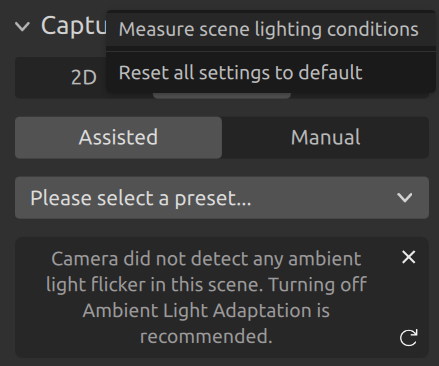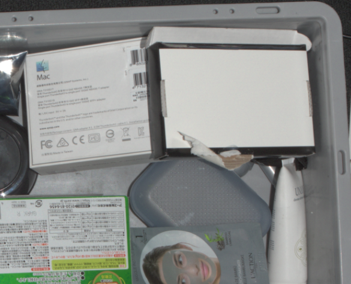Exposure Time(曝光时间)
介绍
曝光时间,也称为快门速度,是指单张相机图像曝光的时间。换句话说,就是快门保持打开的时间。
Zivid相机拍摄多张图像来生成彩色图像和点云,曝光时间的设定值是单张图像的曝光时间。
Zivid 2 |
Zivid 2+ |
Zivid 2+ R |
Zivid 3 |
|
最短曝光时间 (µs) |
1 677 |
1 677 |
900 |
600 |
最长曝光时间 (µs) |
100 000 |
100 000 |
20 000 |
20 000 |
小技巧
查看 捕获速度计算器 以了解曝光时间如何影响总捕获时间。
强环境光源的干扰
使用 Zivid 相机拍摄图像时,我们会在特定时间窗口内采样光信息。通过利用这个简单的概念,可以避免环境光可能引起的许多问题。
结构光传感器是一种采样系统,其工作采样率与电视和照明等许多公用设施相似。荧光灯通常连接到交流电源。在欧盟,这种电源产生的电压为正弦波,频率为 50 Hz。在其他国家/地区(例如美国),电网频率为 60 Hz。
假设有一台帧率为 30 fps 的相机。在欧洲,将它对准荧光灯并按下录制按钮。您会发现视频中似乎有闪烁。您在车库或仓库内使用智能手机拍摄时也可能遇到过这种现象。
现在考虑一台相机,其捕获率与环境光源的频率相匹配。最终,您会在每幅图像中以相同的相位对光进行采样,这种情况下闪烁似乎消失了。这会使光看起来是稳定的。
以上所解释的概念称为相关采样,在结构光 3D 扫描仪中具有良好的效果。通过选择满足以下方程的曝光时间,它可以滤除来自环境光源的随时间变化的噪声:
其中 \(n\) 是正整数, \(f_s\) 是光源的频率。
在存在强烈闪烁的环境光源的情况下,请使用电网周期倍数的采样率(曝光时间):
在 50 Hz 电网频率下为 10 000 µs 的倍数。
在 60 Hz 电网频率下为 8 333 µs 的倍数。
采用直流电源的光源,例如聚光灯,或者≥1kHz的LED,不会产生随时间变化的噪声。
干扰对彩色图像的影响
测量环境光闪烁频率
Zivid 相机可以检测场景中的闪烁并区分 50 Hz 和 60 Hz 电网的干扰。
打开 Zivid Studio 并连接到您的相机。点击 Capture 部分中的三个点。然后点击 Measure scene lighting conditions 。软件将显示检测到的环境光闪烁频率。

或者,使用 SDK 测量环境光条件。此方法将报告是否检测到明显的环境光闪烁,以及它对应的电网频率是 50 Hz 还是 60 Hz。
std::cout << "Measuring scene conditions" << std::endl;
auto sceneConditions = camera.measureSceneConditions();
auto flickerClassification = sceneConditions.ambientLight().flickerClassification().toString();
std::cout << "Flicker classification: " << flickerClassification << std::endl;
auto flickerFrequency = sceneConditions.ambientLight().flickerFrequency();
std::cout << "Measured flickering frequency in the scene: " << flickerFrequency << " Hz." << std::endl;
Console.WriteLine("Measuring scene conditions");
var sceneConditions = camera.MeasureSceneConditions();
var flickerClassification = sceneConditions.AmbientLight.FlickerClassification.ToString();
Console.WriteLine("Flicker classification: " + flickerClassification);
var flickerFrequency = sceneConditions.AmbientLight.FlickerFrequency;
Console.WriteLine($"Measured flickering frequency in the scene: {flickerFrequency} Hz.");
print("Measuring scene conditions")
scene_conditions = camera.measure_scene_conditions()
flicker_classification = scene_conditions.ambient_light.flicker_classification
print(f"Flicker classification: {flicker_classification}")
flicker_frequency = scene_conditions.ambient_light.flicker_frequency
print(f"The measured flickering frequency in the scene: {flicker_frequency} Hz.")
50 Hz 环境光适应
下表列出了在使用 50 Hz 电网频率的国家/地区建议使用的一些曝光时间。请注意,您还可以使用 10 000 µs 的其他倍数,例如 30 000 µs 和 50 000 µs。
曝光时间(µs) |
10 000 |
20 000 |
40 000 |
80 000 |
100 000 |
Stops |
0 |
+1 |
+2 |
+3 |
+3.32 |
60 Hz 环境光适应
下表列出了一些在采用 60 Hz 电力线频率的国家/地区推荐的曝光时间。请注意,您也可以使用 8333 微秒的其他倍数,例如 24999 微秒和 41665 微秒。
曝光时间(µs) |
8 333 |
16 667 |
33 333 |
66 667 |
83 333 |
Stops |
0 |
+1 |
+2 |
+3 |
+3.32 |
如果调整曝光时间以匹配电网频率导致图像过曝等问题,请考虑将 2D 采样间隔 与您所在区域的电网频率同步(仅限 Zivid 3)。
版本历史
SDK |
变更 |
|---|---|
2.16.0 |
增加了对测量环境光闪烁频率的支持。 |
2.14.0 |
增加了对 Zivid 2+ MR130、LR110 和 MR60 的支持,最短曝光时间为 900 µs。 |

